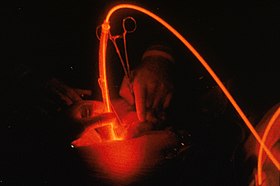
Back علاج ضوئي ديناميكي Arabic Fotodinamička terapija BS Fotodynamická terapie Czech Photodynamische Therapie German Φωτοχημειοθεραπεία Greek Terapia fotodinámica Spanish فوتوداینامیک تراپی Persian Thérapie photodynamique French Teiripe fhótaidinimiciúil Irish טיפול פוטודינמי HE
| Photodynamic therapy | |
|---|---|
 Light activation during photodynamic therapy targeting a tumor | |
| Other names | Photochemotherapy |
Photodynamic therapy (PDT) is a form of phototherapy involving light and a photosensitizing chemical substance used in conjunction with molecular oxygen to elicit cell death (phototoxicity).[1]
PDT is used in treating acne, wet age-related macular degeneration, psoriasis, and herpes. It is used to treat malignant cancers,[2] including head and neck, lung, bladder and skin.
Advantages lessen the need for delicate surgery and lengthy recuperation and minimal formation of scar tissue and disfigurement. A side effect is the associated photosensitisation of skin tissue.[3]
- ^ Dougherty, Thomas J. (17 June 1998). "Photodynamic Therapy". JNCI: Journal of the National Cancer Institute. 90 (12): 889–905. doi:10.1093/jnci/90.12.889. PMC 4592754. PMID 9637138.
- ^ Wang, SS; J Chen; L Keltner; J Christophersen; F Zheng; M Krouse; A Singhal (2002). "New technology for deep light distribution in tissue for phototherapy". Cancer Journal. 8 (2): 154–63. doi:10.1097/00130404-200203000-00009. PMID 11999949. S2CID 24376095.
Lane, N (January 2003). "New Light on Medicine". Scientific American. 288 (1): 38–45. Bibcode:2003SciAm.288a..38L. doi:10.1038/scientificamerican0103-38. PMID 12506423. - ^ Cite error: The named reference
:0was invoked but never defined (see the help page).
© MMXXIII Rich X Search. We shall prevail. All rights reserved. Rich X Search